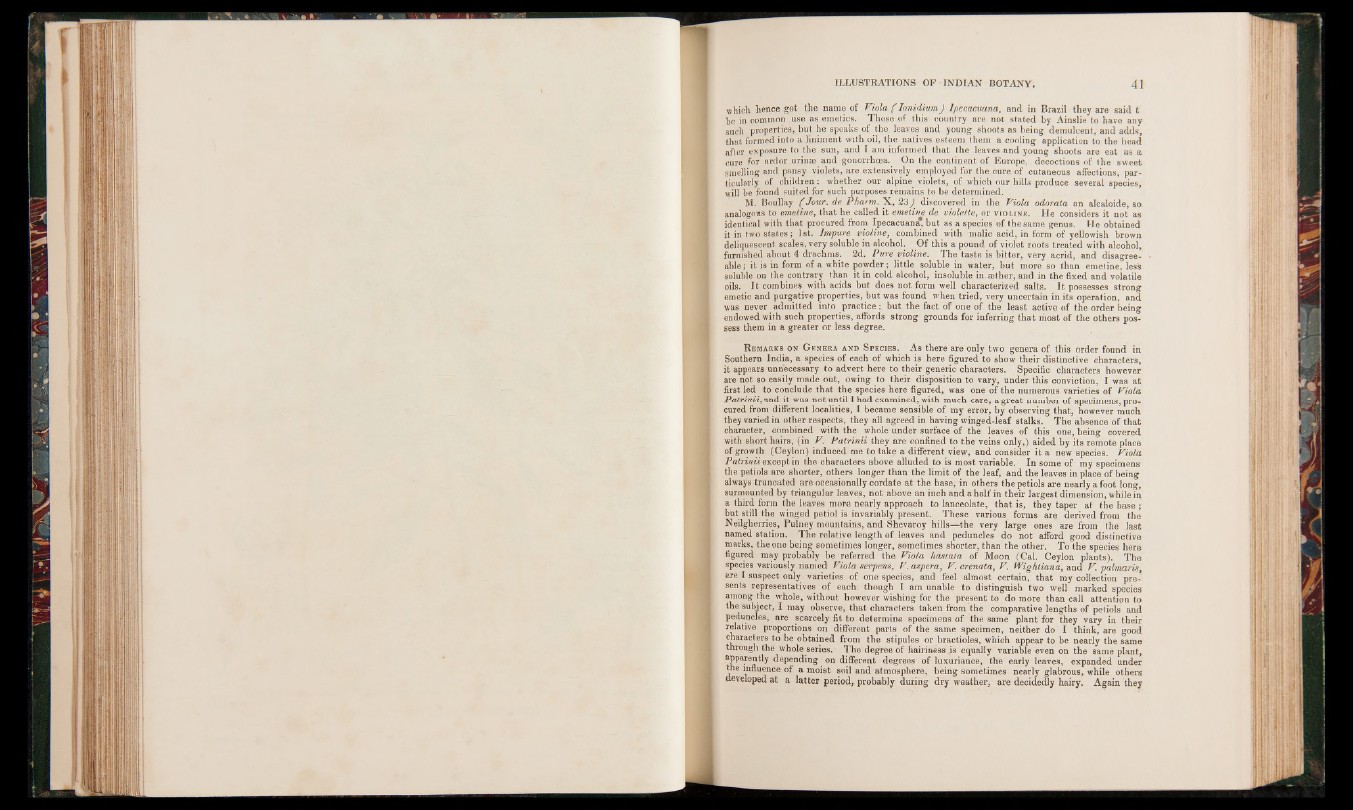
which hence got the name of Viola (Ionidium) lpecacuana, and in Brazil they are said t
be in common use as emetics. Those of this country are not stated by Ainslie to have any
such properties, but he speaks of the leaves and young shoots as being demulcent, and adds,
that formed into a liniment with oil, the natives esteem them a cooling application to the head
after exposure to the sun, and f am informed that the leaves and young shoots are eat as a
cure for ardor urinse and gonorrhoea. On the continent of Europe, decoctions of the sweet
smelling and pansy violets, are extensively employed for the cure of cutaneous affections, particularly
of. children: whether our alpine violets, of which our hills produce several species,
will be found suited for such purposes remains to be determined.
M. Boullay ( Jour, de Pharm. X, 23J discovered in the Viola odorata an alcaloide, so
analogous to emetine, that he called it emetine de violette, or violine. He considers it not as
identical with that procured from Ipecacuan£ but as a species of the same genus. He obtained
it in two states; 1st. Impure violine, combined with malic acid, in form of yellowish brown
deliquescent scales, very soluble in alcohol. Of this a pound of violet roots treated with alcohol,
furnished about 4 drachms. 2d. Pure violine. The taste is bitter, very acrid, and disagreeable
; it is in form of a white powder; little soluble in water, but more so than emetine, less
soluble on the contrary than it in cold alcohol, insoluble in.aether, and in the fixed and volatile
oils. It combines with acids but does not form well characterized salts. It possesses strong
emetic and purgative properties, but was found when tried, very uncertain in its operation, and
was never admitted into practice: but the fact of one of the least active of the order being
endowed with such properties, affords strong grounds for inferring that most of the others possess
them in a greater or less degree.
R emarks on G enera and S pecies. As there are only two genera of this order found in
Southern India, a species of each of which is here figured to show their distinctive characters,
it appears unnecessary to advert here to their generic characters. Specific characters however
are not so easily made out, owing to their disposition to vary, under this conviction, I was at
first led to conclude that the species here figured, was one of the numerous varieties of Viola
Patrinii, and it was not until I had examined, with much care, a great number of specimens, procured
from different localities, I became sensible of my error, by observing that, however much
they varied in other respects, they all agreed in having winged-leaf stalks. The absence of that
character, combined with the whole under surface of the leaves of this one, being covered
with short hairs, (in V. Patrinii they are confined to the veins only,) aided by its remote place
of growth (Ceylon) induced me to take a different view, and consider it a new species. Viola
Patrinii except in the characters above alluded to is most variable. In some of my specimens
the petiols are shorter, others longer than the limit of the leaf, and the leaves in place of being
always truncated are occasionally cordate at the base, in others the petiols are nearly a foot long,
surmounted by triangular leaves, not above an inch and a half in their largest dimension, while in
a third form the leaves more nearly approach to lanceolate, that is, they taper at the base ;
but still the winged petiol is invariably present. These various forms are derived from the
Neilgherries, Pulney mountains, and Shevaroy hills—the very large ones are from the last
named station. The relative length of leaves and peduncles do not afford good distinctive
marks, the one being sometimes longer, sometimes shorter, than the other. To the species here
figured may probably be referred the Viola hostata of Moon (Cal. Ceylon plants). The
species variously named Viola serpens, V. aspera, V. crenata, V. Wightiana, and V. palmar is,
are I suspect only varieties of one species, and feel almost certain, that my collection presents
representatives of each, though I am unable to distinguish two well marked species
among the whole, without however wishing for the present to do more than call attention to
the subject, I may observe, that characters taken from the comparative lengths of petiols and
peduncles, are scarcely fit to determine specimens of the same plant for they vary in their
relative proportions on different parts of the same specimen, neither do I think, are good
characters to be obtained from the stipules or bractioles, which appear to be nearly the same
through the whole series. The degree of hairiness .is equally variable even on the same plant,
apparently depending on different degrees of luxuriance, the early leaves, expanded under
the influence of a moist soil and atmosphere, being sometimes nearly glabrous, while others
developed at a latter period, probably during dry weather, are decidedly hairy. Again they